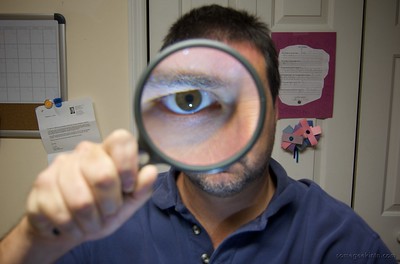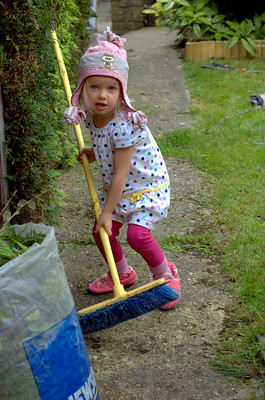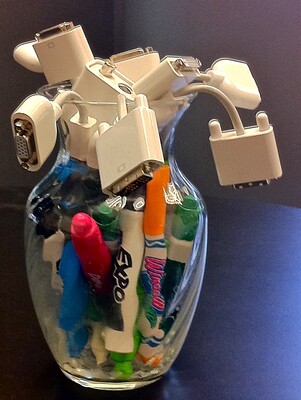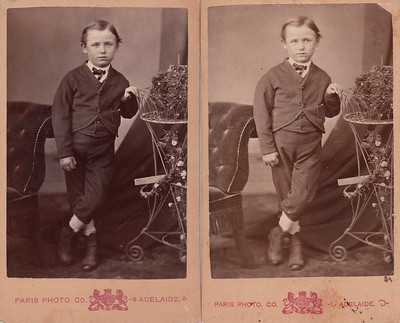Posts Tagged ‘Learning’
The Mighty Capacity Model
 There are natural limits to the amount of work that any one person or group can do. And once that limit is reached, saying yes to more work does not increase the amount of work that gets done. Sure, you kick the can down the road when you say yes to work that you know you can’t get done, but that’s not helpful. Expectations are set inappropriately which secures future disappointment and more importantly binds or blocks other resources. When preparatory work is done for something that was never going to happen, that prep work is pure waste. And when resources are allocated to a future project that was never going to happen, the results are misalignment, mistiming, and replanning, and opportunity cost carries the day.
There are natural limits to the amount of work that any one person or group can do. And once that limit is reached, saying yes to more work does not increase the amount of work that gets done. Sure, you kick the can down the road when you say yes to work that you know you can’t get done, but that’s not helpful. Expectations are set inappropriately which secures future disappointment and more importantly binds or blocks other resources. When preparatory work is done for something that was never going to happen, that prep work is pure waste. And when resources are allocated to a future project that was never going to happen, the results are misalignment, mistiming, and replanning, and opportunity cost carries the day.
But how to know if you the team has what it takes to get the work done? The answer is a capacity model. There are many types of capacity models, but they all require a list of the available resources (people, tools, machines), the list of work to be done (projects), and the amount of time (in hours, weeks, months) each project requires for each resource. The best place to start is to create a simple spreadsheet where the leftmost column lists the names of the people and the resources (e.g., labs, machines, computers, tools). Across the top row of the spreadsheet enter the names of the projects. For the first project, go down the list of people and resources, and for each person/resource required for the project, type an X in the column. Repeat the process for the remainder of the projects.
While this spreadsheet is not a formal capacity model, as it does not capture the number of hours each project requires from the resources, it’s plenty good enough to help you understand if you have a problem. If a person has only one X in their row, only one project requires their time and they can work full-time on that project for the whole year. If another person has sixteen Xs in their row, that’s a big problem. If a machine has no Xs in its row, no projects require that machine, and its capacity can be allocated to other projects across the company. And if a machine has twenty Xs in its row, that’s a big problem.
This simple spreadsheet gives a one-page, visual description of the team’s capacity. Held at arm’s length, the patterns made by the Xs tell the whole story.
To take this spreadsheet to the next level, the Xs can be replaced with numbers that represent the number of weeks each project requires from the people and resources. Sit down with each person and for each X in their row, ask them how many weeks each project will consume. For example, if they are supposed to support three projects, X1 is replaced with 15 (weeks), X2 is replaced with 5, and X3 is replaced with 5 for a total of 25 weeks (15 + 5 + 5). This means the person’s capacity is about 50% consumed (25 weeks / 50 weeks per year) by the three projects. For each resource, ask the resource owner how much time each project requires from the resource. For a machine that is needed for ten projects where each project requires twenty weeks, the machine does not have enough capacity to support the projects. The calculation says the project load requires 200 machine-weeks (10*20 = 200 weeks) and four machines (200 machine-weeks / 50 weeks per year = 4 machines) are required.
Creating a spreadsheet that lists all the projects is helpful in its own right. And you’ll probably learn that there are far more projects than anyone realizes. (Helpful hint: make sure you ask three times if all the projects are listed on the spreadsheet.) And asking people how much time is required for each project is respectful of their knowledge and skillful because they know best how long the work will take. They’ll feel good about all that. And quantifying the number of weeks (or hours) each project requires elevates the discussion from argument to analysis.
With this simple capacity model, the team can communicate clearly which projects can be supported and which cannot. And, where there’s a shortfall, the team can make a list of the additional resources that would be needed to support the full project load.
Fight the natural urge to overcomplicate the first version of the capacity model. Start with a simple project-people/resource spreadsheet and use the Xs. And use the conversations to figure out how to improve it for next time.
Becoming More Innovative
 It’s difficult to describe what an innovative company looks like, and there’s no singular recipe or direction that is right for all companies. Here are some From: To: pairings that I hope will help you in your migration toward innovation. You’re heading in the right direction as your company generates Tos and fewer Froms.
It’s difficult to describe what an innovative company looks like, and there’s no singular recipe or direction that is right for all companies. Here are some From: To: pairings that I hope will help you in your migration toward innovation. You’re heading in the right direction as your company generates Tos and fewer Froms.
From: No one is asking for that technology.
To: What does this new technology stand for?
From: How will the company benefit?
To: How will the customer benefit?
From: What’s the smallest improvement that will make a difference?
To: How can we make the most significant difference?
From: When will you be done?
To: What will you learn?
From: This might not work.
To: How might this work?
From: Start, Start, Continue.
To: Stop, Start, Continue.
From: We’ve tried that before and it didn’t work.
To: What’s changed since last time?
From: What does perfect look like?
To: How is the work done today and which elements can we improve?
From: Defend and Defend the core.
To: Extend and Defend the core.
From: Define the idealized future state.
To: Start with the work.
From: That won’t work!
To: Hey, watch this!
Reducing Time To Market vs. Improving Profits
 X: We need to decrease the time to market for our new products.
X: We need to decrease the time to market for our new products.
Me: So, you want to decrease the time it takes to go from an idea to a commercialized product?
X: Yes.
Me: Okay. That’s pretty easy. Here’s my idea. Put some new stickers on the old product and relaunch it. If we change the stickers every month, we can relaunch the product every month. That will reduce the time to market to one month. The metrics will go through the roof and you’ll get promoted.
X: That won’t work. The customers will see right through that and we won’t sell more products and we won’t make more money.
Me: You never said anything about making more money. You said you wanted to reduce the time to market.
X: We want to make more money by reducing time to market.
Me: Hmm. So, you think reducing time to market is the best way to make more money?
X: Yes. Everyone knows that.
Me: Everyone? That’s a lot of people.
X: Are you going to help us make more money by reducing time to market?
Me: I won’t help you with both. If you had to choose between making more money and reducing time to market, which would you choose?
X: Making money, of course.
Me: Well, then why did you start this whole thing by asking me for help improving time to market?
X: I thought it was the best way to make more money.
Me: Can we agree that if we focus on making more money, we have a good chance of making more money?
X: Yes.
Me: Okay. Good. Do you agree we make more money when more customers buy more products from us?
X: Everyone knows that.
Me: Maybe not everyone, but let’s not split hairs because we’re on a roll here. Do you agree we make more money when customers pay more for our products?
X: Of course.
Me: There you have it. All we have to do is get more customers to buy more products and pay a higher price.
X: And you think that will work better than reducing time to market?
Me: Yes.
X: And you know how to do it?
Me: Sure do. We create new products that solve our customers’ most important problems.
X: That’s totally different than reducing time to market.
Me: Thankfully, yes. And far more profitable.
X: Will that also reduce the time to market?
Me: I thought you said you’d choose to make more money over reducing time to market. Why do you ask?
X: Well, my bonus is contingent on reducing time to market.
Me: Listen, if the previous new product development projects took two years, and you reduce the time to market to one and half years, there’s no way for you to decrease time to market by the end of the year to meet your year-end metrics and get your bonus.
X: So, the metrics for my bonus are wrong?
Me: Right.
X: What should I do?
Me: Let’s work together to launch products that solve important customer problems.
X: And what about my bonus?
Me: Let’s not worry about the bonus. Let’s worry about solving important customer problems, and the bonuses will take care of themselves.
Image credit — Quinn Dombrowski
X: Me: format stolen from @swardley. Thank you, Simon.
The Power of Leaving a Problem Unsolved
 Nothing changes unless there’s a problem.
Nothing changes unless there’s a problem.
In fact, without a problem, there can be no solution.
One of the devious ways to solve your problem is to create conditions for others to think it’s their problem.
Shame on you if you try to get me to solve your problem.
And shame on me if I try to solve your problem.
The best way for the problem to find its rightful owner is to leave the problem unsolved.
But leaving the problem unsolved also increases the pressure on all the innocent non-owners that work near the problem.
Leaving the problem unsolved is like a game of chicken, where the person who flinches first loses.
No one can give you their problem without your consent, but that doesn’t mean they won’t try.
So, when someone tries to give you their problem, put your hands in your pockets.
Leaving the problem unsolved isn’t a sign of non-caring, it’s a sign of higher-level caring.
Leaving the problem unsolved is the only way to pressure the company into the higher-level (and unpleasant) organizational learning of who is not solving their own problems.
“Prepare for Squirting” by Wootang01 is licensed under CC BY-ND 2.0.
What does work look like?
 What does work look like when you prioritize your happiness?
What does work look like when you prioritize your happiness?
When it’s announced that open positions will not be backfilled to meet the practical realities of a recession, you reduce the scope of your projects and push out their completion dates to match the reduction in resources. And the impact on your career? I don’t know, but the people that work for you and everyone else that knows how the work is done will move mountains for you.
Under the banner of standard work, you are given the same task as the one you just completed. Sure, you can do it efficiently and effectively, but if you do that same work one more time, your brain will fall off. So, instead of doing it yourself, you give the work to a lesser-experienced person who is worthy of investment and help them get the work done. They get to learn new skills and the work is done well because you keep them on the straight and narrow. And you get to be a teacher and create a future leader that the company will need in a couple of years. And the downside? The work takes a little longer, but so what.
What does work look like when you prioritize your health?
When an extra-early meeting is scheduled because everyone’s regular day is already fully booked with meetings, you decline the meeting so you can get the recommended amount of sleep recommended by the health professionals. And the negative consequences to your career progression? Well, that’s a choice for your company.
When you get home from work, you disconnect your phone from the company network so you won’t be distracted by work-related interruptions. Because you separated yourself from work, after dinner is cleaned up you can make a healthy lunch for tomorrow. If there’s some downside risk to your career, find another company to work for.
What does work look like when you prioritize your family?
When an extra-late meeting is scheduled because everyone’s regular day is already fully booked with meetings, you decline the meeting so you can cook dinner and eat with your family. The conversation with the kids is mundane and meaningful and ten years from now they’ll be better for it. And the negative consequences? None, because tomorrow morning you can read the minutes of the meeting.
When you’re on your yearly holiday with your family and your boss calls your cell phone to ask you to come back to work early to deal with an emergency, you don’t answer the call and let it go to voicemail. Then, when you get back to the office after vacation, you listen to the voicemail and check in with your boss. And because you didn’t pick up the call, someone else had greatness thrust upon them and developed into someone who can solve emergencies. Now there are two of you. And the downside? Well, I think that depends on your boss.
“Looking For Clues (188 / 365)” by somegeekintn is licensed under CC BY 2.0.
Students, Teachers, and Learning
 If the student has no interest, they are not yet a student and it’s not yet time for learning.
If the student has no interest, they are not yet a student and it’s not yet time for learning.
Learning comes hard, especially when it’s not wanted.
The teacher that tries to teach a student that’s not yet a student is not yet a teacher.
There can be no teacher without a student.
If there’s no doing, there’s no learning. And it’s the same if there’s no theory.
Apprenticeship creates deep learning, but it takes two years.
Learning is inefficient, but it’s far more efficient than not learning.
When you know the student is ready, turn your back so they can see it for themselves.
Objective evidence of deep learning: When students can navigate situations that are outside the curriculum.
“May 14, 2006: Happy Mother’s Day” by Matt McGee is licensed under CC BY-ND 2.0.
Helping helps.
 If you think asking for help is a sign of weakness, you won’t get the help you deserve.
If you think asking for help is a sign of weakness, you won’t get the help you deserve.
If the people around you think asking for help is a sign of weakness, find new people.
As a leader, asking others for help makes it easier for others to ask for help.
When someone asks you for help, help them.
If you’re down in the dumps, help someone.
Helping others is like helping yourself twice.
Helping is caring in action.
If you help someone because you want something in return, people recognize that for what it is.
Done right, helping makes both parties stand two inches taller.
Sometimes the right help gives people the time and space to work things out for themselves.
Sometimes the right help asks people to do work outside their comfort zone.
Sometimes the right help is a difficult conversation.
Sometimes the right help is a smile, a phone call, or a text.
And sometimes the right help isn’t recognized as help until six months after the fact.
Here’s a rule to live by – When in doubt, offer help.
“Helping Daddy” by audi_insperation is licensed under CC BY 2.0.
Problems, Learning, Business Models, and People
 If you know the right answer, you’re working on an old problem or you’re misapplying your experience.
If you know the right answer, you’re working on an old problem or you’re misapplying your experience.
If you are 100% sure how things will turn out, let someone else do it.
If there’s no uncertainty, there can be no learning.
If there’s no learning, your upstart competitors are gaining on you.
If you don’t know what to do, you’ve started the learning cycle.
If you add energy to your business model and it delivers less output, it’s time for a new business model.
If you wait until you’re sure you need a new business model, you waited too long.
Successful business models outlast their usefulness because they’ve been so profitable.
When there’s a project with a 95% chance to increase sales by 3%, there’s no place for a project with a 50% chance to increase sales by 100%.
When progress has slowed, maybe the informal networks have decided slower is faster.
If there’s something in the way, but you cannot figure out what it is, it might be you.
“A bouquet of wilting adapters” by rexhammock is licensed under CC BY-SA 2.0.
How To Solve Transparent Problems
 One of the best problems to solve for your customers is the problem they don’t know they have. If you can pull it off, you will create an entirely new value proposition for them and enable them to do things they cannot do today. But the problem is they can’t ask you to solve it because they don’t know they have it.
One of the best problems to solve for your customers is the problem they don’t know they have. If you can pull it off, you will create an entirely new value proposition for them and enable them to do things they cannot do today. But the problem is they can’t ask you to solve it because they don’t know they have it.
To identify problems customs can’t see, you’ve got to watch them go about their business. You’ve got to watch all aspects of their work and understand what they do and why they do it that way. And it’s their why that helps you find the transparent problems. When they tell you their why, they tell you the things they think cannot change and the things they consider fundamental constraints. Their whys tell you what they think is unchangeable. And from their perspective, they’re right. These things are unchangeable because they don’t know what’s possible with new technologies.
Once you know their unchangeable constraints, choose one to work on and turn it into a tight problem statement. Then use your best tools and methods to solve it. Once solved, you’ve got to make a functional prototype and show them in person. Without going back to them with a demonstration of a functional prototype, they won’t believe you. Remember, you did something they didn’t think was possible and changed the unchangeable.
When demonstrating the prototype to the customer, just show it in action. Don’t describe it, just show them and let them ask questions. Listen to their questions so you can see the prototype through their eyes. And to avoid leading the witness, limit yourself to questions that help you understand why they see the prototype as they do. The way they see the prototype will be different than your expectations, and that difference is called learning. And if you find yourself disagreeing with them, you’re doing it wrong.
This first prototype won’t hit the mark exactly, but it will impress the customer and it will build trust with them. And because they watched the prototype in action, they will be able to tell you how to improve it. Or better yet, with their newfound understanding of what’s possible, they might be able to see a more meaningful transparent problem that, once solved, could revolutionize their industry.
Customers know their work and you know what’s possible. And prototypes are a great way to create the future together.
“Transparent” by Rene Mensen is licensed under CC BY 2.0.
Triangulation of Leadership
Put together things that contradict yet make a wonderfully mismatched pair.
Say things that contradict common misunderstandings.
See the dark and dirty underside of things.
Be more patient with people.
Stomp on success.
Dissent.
Tell the truth even when it’s bad for your career.
See what wasn’t but should have been.
Violate first principles.
Protect people.
Trust.
See things as they aren’t.
See what’s missing.
See yourself.
See.
“man in park (triangulation)” by Josh (broma) is licensed under CC BY 2.0.
Same-But-Different, A Superpower That Can Save The Day
 If there’s one superpower to develop, it’s to learn how to assess a project and get a good feel for when it will launch.
If there’s one superpower to develop, it’s to learn how to assess a project and get a good feel for when it will launch.
When you want to know how long a project will take, ask this simple question: ‘What must the project team learn before the project can launch?” By starting with this single question, you will start the discussion that will lead you to an understanding of what hasn’t been done before and where the uncertainty is hiding. And if there’s one thing that can accelerate a project, it’s defining where the uncertainty is hiding. And knowing this doubly powerful, like a pure two-for-one, because if you know where uncertainty is, by definition, you know where it isn’t. Where the uncertainty isn’t, you can do what you did last time, and because you’ve done it before, you know how long it will take. No new tools, no new methods, no new analyses, no new machines, no new skillsets, no new anything. And for the remaining elements of the project, well, that’s where the uncertainty is hiding and that’s where you will focus on the learning needed to secure the launch.
But it can be difficult to understand the specific learning that must be done for a project to launch. One trick I like to use is the Same-But-Different method. It goes like this. Identify a project that launched (Project A) that’s most similar to the one that will launch next (Project B) and perform a subtraction of sorts. Declare that Project B (the one you want to launch) is the same as Project A (the one you already launched) but different in specific ways and then define those differences as clearly and tightly as possible. And where it’s different, that’s where the learning energy must be concentrated.
Same-But-Different sounds simplistic and trivial, but it isn’t. More than anything, it’s powerful. For the elements that are the same, you do what you did last time, which is freeing. And for the small subset if things that are different, you dig in!
Same-But-Different drives deep clarity and extreme focus, which result in blistering progress and blinding effectiveness.
And for some reason unknown to me, asking a team to define the novel elements of a project is at least fifty times more difficult than asking them how Project B is different than Project A. So, it feels good to the team when they can use Same-But-Different to quickly easily define what’s different and then point directly to the uncertainty. And once the team knows where the uncertainty is hiding, it’s no longer hiding.
And if there’s one thing a project team likes, it’s knowing where the uncertainty is hiding.
“The same, but different by the Paris Photographic Co. (c.1880)” by pellethepoet is marked with CC BY 2.0.

 Mike Shipulski
Mike Shipulski